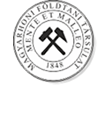- Magyar
- English
LRG szeminárium JÚNIUS 5. – The manifestations of CO 2 degassing in the Eastern Carpathians
JÚNIUS 5.
The manifestations of CO 2 degassing in the Eastern Carpathians
Kis Boglárka-Mercedesz
a Babeș-Bolyai Tudományegyetem oktatójának előadása a
Litoszféra Fluidum Kutató Laboratórium szervezésében.
Időpont: 2023. 06. 05. 14:00 - 15:00
Helyszín: ELTE Lágymányosi Campus, Déli Tömb (1117 Budapest, Pázmány P. sétány 1/C)
Sztrókay terem (00-708) és Zoom platform
Zoom, regisztráció: https://forms.gle/hfrGLivSVLh51mms5
Abstract:
To understand the global carbon cycle and the CO 2 input into the atmosphere from natural/geological reservoirs, scientists found important the mapping of natural degassing sites and quantification of carbon fluxes. Besides the active volcanoes, which are the major emitters, high fluxes of CO 2 were identified and measured at dormant volcanic and active tectonic areas. Both the thrusted and folded nappe systems and the volcanic units of the Eastern Carpathians are characterized by intense CO 2 degassing. Degassing occurs in different forms; the most common manifestations being represented by the carbonated mineral water springs of different hydrogeochemical characteristics (Fig.1). These natural springs are consumed by the inhabitants (hundreds of people) for drinking water, daily. They also have remarkable therapeutical value and economic impact on the region that hosts the biggest bottling plants in Romania (Borsec, Dorna, Perla Harghitei). Mapping and protection of these sites should be crucial. Other forms of degassing are focused gas emissions and diffuse degassing from the soil. Focused gas vents can be either dry emanations, that are not visible with the naked eye, or, when accompanied by groundwater they can form bubbling pools. Diffuse degassing from the
soil is often masked by vegetation and bacterial activity and it is strongly influenced by meteorological conditions. These manifestations can have high gas fluxes, but their quantification needs special techniques. In our presentation, we try to give an insight into the types of degassing manifestations in the Eastern Carpathians and the importance of their mapping.
About the speaker:
Boglárka-Mercedesz Kis is currently a lecturer at Babeș-Bolyai University (BBTE), Cluj- Napoca (Kolozsvár). Boglárka defended her PhD thesis in 2014 on the topic of Hydrogeochemistry of mineral waters from the Eastern Carpathians-Transylvanian Basin boundary. In 2014, she joined the Lithosphere Fluid Research Group as a researcher. From 2015 to 2019 she had postdoc and researcher positions at MTA-ELTE Volcanology Research Group. Between 2019 and 2020 she worked at the Isotope Climatology and Environmental
Research Centre, Debrecen, Hungary. Her own research projects started in 2017 with the Solti Gizella Award titled “Geochemistry and gas flux on the youngest volcano within the Carpathian-Pannonian region”. Then under her leadership a project named “Geochemistry of Gas Emissions in the Volcano-Tectonic environment of the Eastern Carpathians: geologic and social impact” was completed in the frame of UEFISCDI, Romania. Boglárka started her teaching activities from 2014 at the Sapientia Hungarian University of Transylvania, Cluj-Napoca. Since 2017 she is a lecturer at the BBTE and teaching wide range of Earth and Environmental courses: Geochemistry, Environmental Geology, Hydrogeology, Soil Science, Geological Exploration.
About the LRG:
Since the formation of the Lithosphere Fluid Research Laboratory (LRG) in 1998, the group led by Csaba Szabó published more than 100 peer-reviewed scientific publications, 25 PhD theses and more than 50 TDK and OTDK winning student theses. In their scientific work, the students of the LRG cover broad areas of geochemistry of the lithosphere and its fluids, such as fluid and melt inclusions in various geological environments, petrology of the lower crust and the upper mantle, geological storage of CO 2 and H 2 , the source and fate of radon, or environmental and urban geochemistry of former industrial centers. The LRG initiated this seminar series in 2019, to invite former students of the laboratory (who are now accomplished scientists) to present their research to the next generation of geochemists.
Az angol nyelvű előadás az online résztvevőknek a Zoom platformon lesz meghallgatható.
Online részvétel esetén szükséges regisztrálni, amely az alábbi linken megtehető:
https://forms.gle/hfrGLivSVLh51mms5
Kapcsolat: gecso@staff.elte.hu

























